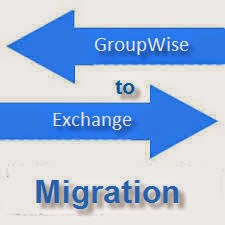Owing to the advancement in technologies,
companies are now planning to migrate from GroupWise to Microsoft Exchange
Server 2010 with an aim to reap maximum benefits indeed. Undoubtedly, in the
recent past Microsoft Exchange Server 2010 had took a colossal leap frontward
in terms of flexibility of incorporation, cost of ownership and of course ease
of management and exercise. Its capability for online deployments and to
integrate on-premises closely is the crucial aspect of new functionality of the
server. Migrating to Exchange Server 2010 can offer several visible benefits to
the business. So, below is the list of few important tips to assist you
accomplish the migration process smoothly and prevent all challenges,
guaranteeing you impeccable move.
Must
Perform Pre-Migration Review
Before you start the migration process, it is
quite crucial for you to understand clearly what will be involved in the
process and what criterions you will be using to evaluate successfully
accomplishment. Remember, it is not necessary that each message in GroupWise
will remain unscathed after the process of migration; therefore it becomes
quite difficult for you to expect cent percent data migration without any harm.
Moreover, you need to select a threshold, for instance, 90% of message should
be migrated initially for 90% of mailboxes and closely monitor the migration
percentage. Remember, checking the outcomes closely is the key to any
successful migration and this would be possible for you indeed, especially if
you start with pre-migration assessment.
Provision
Exchange 2010 Mailboxes
Before you start generating Active Directory
items for Exchange Server 2010 mailboxes, it is important for you to know that
GroupWise directory are totally different from e-Directory and hence the
GroupWise resources never utilize e-Directory user objects. So, if you are
looking forward to transfer user objects to e-Directory, then first you need to
generate them with the use of a mechanism that is totally different from what
you usually use to create standard user objects.
Incorporate
GroupWise and Exchange 2010
Also, you need to discover how synchronization
between GroupWise and Exchange Server 2010 can be accomplished effectively so
as to ensure that Exchange Global Address List and GroupWise Address Book
imitate that same users, assets and distribution groups. You need to make use
of SMTP routing so as to route mail amongst GroupWise and MS Exchange 2010 and
between united GroupWise/Exchange hybrid system and the external world. Please
check the message set-up and the message size restrictions.
You can easily achieve smooth mail flow
between GroupWise and Exchange 2010 in two effective ways.
- Exchange 2003 Connector for Novell GroupWise
- SMTP forward domain
If you set up Exchange Server 2003 machine
running the correct coexistence connectors before installing MS Exchange 2010,
then you may make use of calendar free-busy lookup.
Run
a Pilot Migration
The primary aim of pilot migration is to determine
the challenges that you may encounter once the complete migration process
starts. The pilot migration will also help you to find out the methods to
prevent such challenges and resolve them. So, it is common to face troubles and
challenges throughout the pilot migration, where you will encounter envoy
sample of troubles which may occur during migration. Remember, if the mailboxes
for migration are in low thousands, then over 5% of total people may give a
good example. Moreover, the percentage may even decrease if the migrations are
bigger enough.
Before instigating the pilot migration
process, it is important for you to determine how smooth and faster the data
can be transferred, simply by conducting a controlled migration of identified
quantity of production GroupWise data on individual migration server. Through this
process you can easily get the migration baseline which is based on throughput
in GB/hour. With throughput one can easily determine the time required to
transfer the total data volume.
Through pilot migration, one can easily find
out how much disk space is required on the target, which may vary from the
source, depending upon the edition of Novell GroupWise and also the platform on
which it is running. Remember, usually the volume of data on target is always
larger compared to the data on source. The sole way to determine how the data
will perform after migration is to test the data.
Migrate
Data and Track Migration Progress
Once each batch of mailboxes is transferred,
you need to track down the number of messages migrated, along with the total
number of errors or notices and number of messages filtered or missed out per
mailbox. Try to opt for effective software solution to conduct this task and
the software should have separate logs for each transferred mailbox that
comprises the total number of appointments and messages the mailbox encloses
before migration. Also, try to enclose the number of missed out objects to
number of moving objects and deduct the number of errors and then divide the
outcomes by the total message count, this will help you to find out the
approximate percentage. If the percentage is 98+, then you may rest assured and
sign off on the mailbox as a successful achievement.
Note
- If you are unable to migrate GroupWise to MS Exchange Server 2010 with the
use of aforementioned tips, then you may make use of third party GroupWise to MS Exchange Server migration software. The third party migration software will
help to migrate GroupWise to MS Exchange Server 2010 easily, without causing
any damage or data loss throughout the migration process.

No comments:
Post a Comment